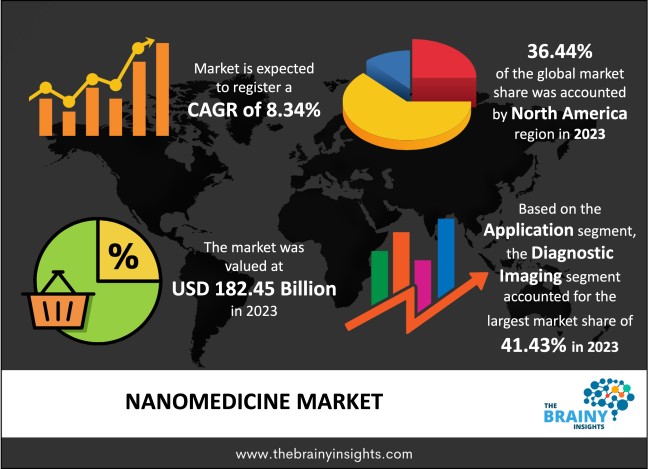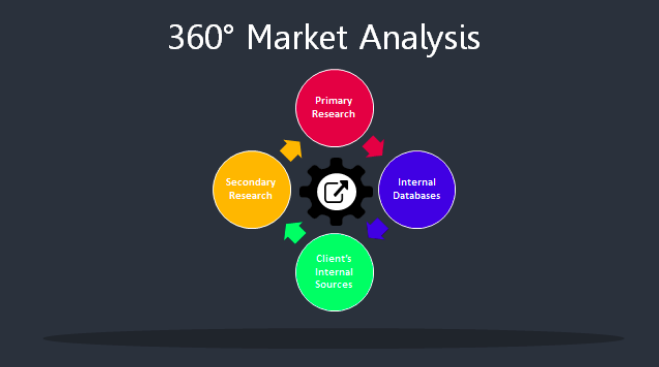- +1-315-215-1633
- sales@thebrainyinsights.com

The global nanomedicine market is expected to reach USD 406.57 billion by 2033, at a CAGR of 8.34% during the forecast period 2024 to 2033. Asia Pacific is expected to grow the fastest during the forecast period. There is a growing demand for innovative drug delivery technologies as traditional delivery systems often face challenges, including the possibility of side effects.
Nanomedicine is the term used to describe specialized, multi-purpose pharmaceuticals with programmable characteristics utilized to cure illnesses and repair tissues at the molecular level. The diagnosis, treatment, and prevention of a disease, as well as the examination of the underlying pathophysiology, involves the use of nanoparticles, nanotubes, and nanodevices, such as imaging agents, nanorobots, biochips, and polymer therapies. Liposomes, inorganic particles, metal and metal oxide nanoparticles, and other substances are utilized to deliver medications to the body. As a result, nanomedicine has a wide range of uses, including drug delivery, imaging for diagnosis, vaccinations, regenerative drugs, and implants. One of the main elements fostering a favourable view for the industry is the rising frequency of chronic medical conditions worldwide. Treatment of oncological, neurological, urological, infectious, ophthalmological, orthopaedic, immunological, and cardiovascular illnesses is greatly aided by nanomedicine. In keeping with this, a movement in consumer preference for tailored medications is also fostering market expansion. Aside from that, other growth-promoting aspects include numerous nanoscale technology developments for better diagnostic methods. Pharmaceutical companies are adopting nanorobotic systems and different cutting-edge approaches to administer nanomedicines effectively. The market is expected to increase due to additional factors, such as advancements in healthcare infrastructure and intense biotechnology-related research and development (R&D) activities.

Get an overview of this study by requesting a free sample
1. Introduction
1.1. Objectives of the Study
1.2. Market Definition
1.3. Research Scope
1.4. Currency
1.5. Key Target Audience
2. Research Methodology and Assumptions
3. Executive Summary
4. Premium Insights
4.1. Porter’s Five Forces Analysis
4.2. Value Chain Analysis
4.3. Top Investment Pockets
4.3.1. Market Attractiveness Analysis By Application
4.3.2. Market Attractiveness Analysis By Disease
4.3.3. Market Attractiveness Analysis By Region
4.4. Industry Trends
5. Market Dynamics
5.1. Market Evaluation
5.2. Drivers
5.2.1. Increase in Application
5.3. Restraints
5.3.1. Stringent Regulations
5.4. Opportunities
5.4.1. Rise in Government Initiatives
5.5. Challenges
5.5.1. Lack of Knowledge
6. Global Nanomedicine Market Analysis and Forecast, By Application
6.1. Segment Overview
6.2. Biomaterials
6.3. Drug Delivery
6.4. Diagnostic Imaging
6.5. Active Implants
6.6. Tissue Regeneration
7. Global Nanomedicine Market Analysis and Forecast, By Disease
7.1. Segment Overview
7.2. Oncological Diseases
7.3. Cardiovascular Diseases
7.4. Orthopedic Diseases
7.5. Neurological Diseases
7.6. Infectious Diseases
7.7. Others
8. Global Nanomedicine Market Analysis and Forecast, By Regional Analysis
8.1. Segment Overview
8.2. North America
8.2.1. U.S.
8.2.2. Canada
8.2.3. Mexico
8.3. Europe
8.3.1. Germany
8.3.2. France
8.3.3. U.K.
8.3.4. Italy
8.3.5. Spain
8.4. Asia-Pacific
8.4.1. Japan
8.4.2. China
8.4.3. India
8.5. South America
8.5.1. Brazil
8.6. Middle East and Africa
8.6.1. UAE
8.6.2. South Africa
9. Global Nanomedicine Market-Competitive Landscape
9.1. Overview
9.2. Market Share of Key Players in Global Nanomedicine Market
9.2.1. Global Company Market Share
9.2.2. North America Company Market Share
9.2.3. Europe Company Market Share
9.2.4. APAC Company Market Share
9.3. Competitive Situations and Trends
9.3.1. product Launches and Developments
9.3.2. Partnerships, Collaborations, and Agreements
9.3.3. Mergers & Acquisitions
9.3.4. Expansions
10. Company Profiles
10.1. Abbott Laboratories
10.1.1. Business Overview
10.1.2. Company Snapshot
10.1.3. Company Market Share Analysis
10.1.4. Company product Portfolio
10.1.5. Recent Developments
10.1.6. SWOT Analysis
10.2. Celgene Corporation
10.2.1. Business Overview
10.2.2. Company Snapshot
10.2.3. Company Market Share Analysis
10.2.4. Company product Portfolio
10.2.5. Recent Developments
10.2.6. SWOT Analysis
10.3. Combi Matrix Corporation
10.3.1. Business Overview
10.3.2. Company Snapshot
10.3.3. Company Market Share Analysis
10.3.4. Company product Portfolio
10.3.5. Recent Developments
10.3.6. SWOT Analysis
10.4. General Electric
10.4.1. Business Overview
10.4.2. Company Snapshot
10.4.3. Company Market Share Analysis
10.4.4. Company Product Portfolio
10.4.5. Recent Developments
10.4.6. SWOT Analysis
10.5. Nano spectra Biosciences, Inc.
10.5.1. Business Overview
10.5.2. Company Snapshot
10.5.3. Company Market Share Analysis
10.5.4. Company product Portfolio
10.5.5. Recent Developments
10.5.6. SWOT Analysis
10.6. Mallinckrodt Pharmaceuticals
10.6.1. Business Overview
10.6.2. Company Snapshot
10.6.3. Company Market Share Analysis
10.6.4. Company product Portfolio
10.6.5. Recent Developments
10.6.6. SWOT Analysis
10.7. Johnson & Johnson Services, Inc.
10.7.1. Business Overview
10.7.2. Company Snapshot
10.7.3. Company Market Share Analysis
10.7.4. Company product Portfolio
10.7.5. Recent Developments
10.7.6. SWOT Analysis
10.8. Pfizer, Inc.
10.8.1. Business Overview
10.8.2. Company Snapshot
10.8.3. Company Market Share Analysis
10.8.4. Company product Portfolio
10.8.5. Recent Developments
10.8.6. SWOT Analysis
10.9. Merck & Co., Inc.
10.9.1. Business Overview
10.9.2. Company Snapshot
10.9.3. Company Market Share Analysis
10.9.4. Company product Portfolio
10.9.5. Recent Developments
10.9.6. SWOT Analysis
10.10. Arrowhead Pharmaceuticals, Inc.
10.10.1. Business Overview
10.10.2. Company Snapshot
10.10.3. Company Market Share Analysis
10.10.4. Company product Portfolio
10.10.5. Recent Developments
10.10.6. SWOT Analysis
List of Table
1. Global Nanomedicine Market, By Application, 2020-2033 (USD Billion)
2. Global Biomaterials, Nanomedicine Market, By Region, 2020-2033 (USD Billion)
3. Global Drug Delivery, Nanomedicine Market, By Region, 2020-2033 (USD Billion)
4. Global Diagnostic Imaging, Nanomedicine Market, By Region, 2020-2033 (USD Billion)
5. Global Active Implants, Nanomedicine Market, By Region, 2020-2033 (USD Billion)
6. Global Tissue Regeneration, Nanomedicine Market, By Region, 2020-2033 (USD Billion)
7. Global Nanomedicine Market, By Disease, 2020-2033 (USD Billion)
8. Global Oncological Diseases, Nanomedicine Market, By Region, 2020-2033 (USD Billion)
9. Global Cardiovascular Diseases, Nanomedicine Market, By Region, 2020-2033 (USD Billion)
10. Global Orthopedic Diseases, Nanomedicine Market, By Region, 2020-2033 (USD Billion)
11. Global Neurological Diseases, Nanomedicine Market, By Region, 2020-2033 (USD Billion)
12. Global Infectious Diseases, Nanomedicine Market, By Region, 2020-2033 (USD Billion)
13. Global Others, Nanomedicine Market, By Region, 2020-2033 (USD Billion)
14. North America Nanomedicine Market, By Application, 2020-2033 (USD Billion)
15. North America Nanomedicine Market, By Disease, 2020-2033 (USD Billion)
16. U.S. Nanomedicine Market, By Application, 2020-2033 (USD Billion)
17. U.S. Nanomedicine Market, By Disease, 2020-2033 (USD Billion)
18. Canada Nanomedicine Market, By Application, 2020-2033 (USD Billion)
19. Canada Nanomedicine Market, By Disease, 2020-2033 (USD Billion)
20. Mexico Nanomedicine Market, By Application, 2020-2033 (USD Billion)
21. Mexico Nanomedicine Market, By Disease, 2020-2033 (USD Billion)
22. Europe Nanomedicine Market, By Application, 2020-2033 (USD Billion)
23. Europe Nanomedicine Market, By Disease, 2020-2033 (USD Billion)
24. Germany Nanomedicine Market, By Application, 2020-2033 (USD Billion)
25. Germany Nanomedicine Market, By Disease, 2020-2033 (USD Billion)
26. France Nanomedicine Market, By Application, 2020-2033 (USD Billion)
27. France Nanomedicine Market, By Disease, 2020-2033 (USD Billion)
28. U.K. Nanomedicine Market, By Application, 2020-2033 (USD Billion)
29. U.K. Nanomedicine Market, By Disease, 2020-2033 (USD Billion)
30. Italy Nanomedicine Market, By Application, 2020-2033 (USD Billion)
31. Italy Nanomedicine Market, By Disease, 2020-2033 (USD Billion)
32. Spain Nanomedicine Market, By Application, 2020-2033 (USD Billion)
33. Spain Nanomedicine Market, By Disease, 2020-2033 (USD Billion)
34. Asia Pacific Nanomedicine Market, By Application, 2020-2033 (USD Billion)
35. Asia Pacific Nanomedicine Market, By Disease, 2020-2033 (USD Billion)
36. Japan Nanomedicine Market, By Application, 2020-2033 (USD Billion)
37. Japan Nanomedicine Market, By Disease, 2020-2033 (USD Billion)
38. China Nanomedicine Market, By Application, 2020-2033 (USD Billion)
39. China Nanomedicine Market, By Disease, 2020-2033 (USD Billion)
40. India Nanomedicine Market, By Application, 2020-2033 (USD Billion)
41. India Nanomedicine Market, By Disease, 2020-2033 (USD Billion)
42. South America Nanomedicine Market, By Application, 2020-2033 (USD Billion)
43. South America Nanomedicine Market, By Disease, 2020-2033 (USD Billion)
44. Brazil Nanomedicine Market, By Application, 2020-2033 (USD Billion)
45. Brazil Nanomedicine Market, By Disease, 2020-2033 (USD Billion)
46. Middle East and Africa Nanomedicine Market, By Application, 2020-2033 (USD Billion)
47. Middle East and Africa Nanomedicine Market, By Disease, 2020-2033 (USD Billion)
48. UAE Nanomedicine Market, By Application, 2020-2033 (USD Billion)
49. UAE Nanomedicine Market, By Disease, 2020-2033 (USD Billion)
50. South Africa Nanomedicine Market, By Application, 2020-2033 (USD Billion)
51. South Africa Nanomedicine Market, By Disease, 2020-2033 (USD Billion)
List of Figures
1. Global Nanomedicine Market Segmentation
2. Global Nanomedicine Market: Research Methodology
3. Market Size Estimation Methodology: Bottom-Up Approach
4. Market Size Estimation Methodology: Top-Down Approach
5. Data Triangulation
6. Porter’s Five Forces Analysis
7. Value Chain Analysis
8. Global Nanomedicine Market Attractiveness Analysis By Application
9. Global Nanomedicine Market Attractiveness Analysis By Disease
10. Global Nanomedicine Market Attractiveness Analysis By Region
11. Global Nanomedicine Market: Dynamics
12. Global Nanomedicine Market Share By Application (2023 & 2033)
13. Global Nanomedicine Market Share By Disease (2023 & 2033)
14. Global Nanomedicine Market Share By Regions (2023 & 2033)
15. Global Nanomedicine Market Share By Company (2023)
This study forecasts global, regional, and country revenue from 2020 to 2033. Brainy Insights has segmented the global nanomedicine market based on the below-mentioned segments:
Global Nanomedicine Market by Application:
Global Nanomedicine Market by Disease:
Global Nanomedicine Market by Region:
Research has its special purpose to undertake marketing efficiently. In this competitive scenario, businesses need information across all industry verticals; the information about customer wants, market demand, competition, industry trends, distribution channels etc. This information needs to be updated regularly because businesses operate in a dynamic environment. Our organization, The Brainy Insights incorporates scientific and systematic research procedures in order to get proper market insights and industry analysis for overall business success. The analysis consists of studying the market from a miniscule level wherein we implement statistical tools which helps us in examining the data with accuracy and precision.
Our research reports feature both; quantitative and qualitative aspects for any market. Qualitative information for any market research process are fundamental because they reveal the customer needs and wants, usage and consumption for any product/service related to a specific industry. This in turn aids the marketers/investors in knowing certain perceptions of the customers. Qualitative research can enlighten about the different product concepts and designs along with unique service offering that in turn, helps define marketing problems and generate opportunities. On the other hand, quantitative research engages with the data collection process through interviews, e-mail interactions, surveys and pilot studies. Quantitative aspects for the market research are useful to validate the hypotheses generated during qualitative research method, explore empirical patterns in the data with the help of statistical tools, and finally make the market estimations.
The Brainy Insights offers comprehensive research and analysis, based on a wide assortment of factual insights gained through interviews with CXOs and global experts and secondary data from reliable sources. Our analysts and industry specialist assume vital roles in building up statistical tools and analysis models, which are used to analyse the data and arrive at accurate insights with exceedingly informative research discoveries. The data provided by our organization have proven precious to a diverse range of companies, facilitating them to address issues such as determining which products/services are the most appealing, whether or not customers use the product in the manner anticipated, the purchasing intentions of the market and many others.
Our research methodology encompasses an idyllic combination of primary and secondary initiatives. Key phases involved in this process are listed below:

The phase involves the gathering and collecting of market data and its related information with the help of different sources & research procedures.

The data procurement stage involves in data gathering and collecting through various data sources.
This stage involves in extensive research. These data sources includes:
Purchased Database: Purchased databases play a crucial role in estimating the market sizes irrespective of the domain. Our purchased database includes:
Primary Research: The Brainy Insights interacts with leading companies and experts of the concerned domain to develop the analyst team’s market understanding and expertise. It improves and substantiates every single data presented in the market reports. Primary research mainly involves in telephonic interviews, E-mail interactions and face-to-face interviews with the raw material providers, manufacturers/producers, distributors, & independent consultants. The interviews that we conduct provides valuable data on market size and industry growth trends prevailing in the market. Our organization also conducts surveys with the various industry experts in order to gain overall insights of the industry/market. For instance, in healthcare industry we conduct surveys with the pharmacists, doctors, surgeons and nurses in order to gain insights and key information of a medical product/device/equipment which the customers are going to usage. Surveys are conducted in the form of questionnaire designed by our own analyst team. Surveys plays an important role in primary research because surveys helps us to identify the key target audiences of the market. Additionally, surveys helps to identify the key target audience engaged with the market. Our survey team conducts the survey by targeting the key audience, thus gaining insights from them. Based on the perspectives of the customers, this information is utilized to formulate market strategies. Moreover, market surveys helps us to understand the current competitive situation of the industry. To be precise, our survey process typically involve with the 360 analysis of the market. This analytical process begins by identifying the prospective customers for a product or service related to the market/industry to obtain data on how a product/service could fit into customers’ lives.

Secondary Research: The secondary data sources includes information published by the on-profit organizations such as World bank, WHO, company fillings, investor presentations, annual reports, national government documents, statistical databases, blogs, articles, white papers and others. From the annual report, we analyse a company’s revenue to understand the key segment and market share of that organization in a particular region. We analyse the company websites and adopt the product mapping technique which is important for deriving the segment revenue. In the product mapping method, we select and categorize the products offered by the companies catering to domain specific market, deduce the product revenue for each of the companies so as to get overall estimation of the market size. We also source data and analyses trends based on information received from supply side and demand side intermediaries in the value chain. The supply side denotes the data gathered from supplier, distributor, wholesaler and the demand side illustrates the data gathered from the end customers for respective market domain.

The supply side for a domain specific market is analysed by:
The demand side for the market is estimated through:
In-house Library: Apart from these third-party sources, we have our in-house library of qualitative and quantitative information. Our in-house database includes market data for various industry and domains. These data are updated on regular basis as per the changing market scenario. Our library includes, historic databases, internal audit reports and archives.
Sometimes there are instances where there is no metadata or raw data available for any domain specific market. For those cases, we use our expertise to forecast and estimate the market size in order to generate comprehensive data sets. Our analyst team adopt a robust research technique in order to produce the estimates:
Data Synthesis: This stage involves the analysis & mapping of all the information obtained from the previous step. It also involves in scrutinizing the data for any discrepancy observed while data gathering related to the market. The data is collected with consideration to the heterogeneity of sources. Robust scientific techniques are in place for synthesizing disparate data sets and provide the essential contextual information that can orient market strategies. The Brainy Insights has extensive experience in data synthesis where the data passes through various stages:


Market Deduction & Formulation: The final stage comprises of assigning data points at appropriate market spaces so as to deduce feasible conclusions. Analyst perspective & subject matter expert based holistic form of market sizing coupled with industry analysis also plays a crucial role in this stage.
This stage involves in finalization of the market size and numbers that we have collected from data integration step. With data interpolation, it is made sure that there is no gap in the market data. Successful trend analysis is done by our analysts using extrapolation techniques, which provide the best possible forecasts for the market.
Data Validation & Market Feedback: Validation is the most important step in the process. Validation & re-validation via an intricately designed process helps us finalize data-points to be used for final calculations.

The Brainy Insights interacts with leading companies and experts of the concerned domain to develop the analyst team’s market understanding and expertise. It improves and substantiates every single data presented in the market reports. The data validation interview and discussion panels are typically composed of the most experienced industry members. The participants include, however, are not limited to:
Moreover, we always validate our data and findings through primary respondents from all the major regions we are working on.
Free Customization
Fortune 500 Clients
Free Yearly Update On Purchase Of Multi/Corporate License
Companies Served Till Date